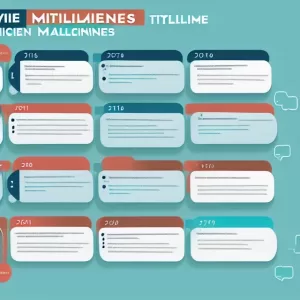How to Create a Minimum Viable Product - A Step By Step MVP Guide
How to create an MVP (Minimum Viable Product) – and why it’s so important when starting a business
So, you have an amazing business idea, but you’re not quite sure how to bring it to life?
Many entrepreneurs face this exact challenge, and one excellent and proven way to navigate it is by creating a Minimum Viable Product (MVP).
In this step-by-step guide, we’ll show you how to create an MVP that will help you test your idea, gather feedback, and refine your product before investing too much time and resources.
First – what is a Minimum Viable Product (MVP)?
An MVP is a basic level version of your core product or service.
If you are a software company it would be a very basic stripped down version of your software. If you are a food service provider, it could be a version of your flagship meal, or if you are a gardening tool inventor, it could be a functional version of your most important gardening tool design.
It’s something that you can give to a potential user to test out and see if they respond to the VALUE you are trying to provide them with.
The purpose of the MVP is to do a quick and dirty version of your core product and test it with real people to see if they really like it, or if they don’t.
This saves you from going into full scale production with your business, only to learn later that users didn’t like your product.
Step 1: Define Your Product’s Core Features
 Start by identifying the core features that make your product unique and valuable to your target audience. Make a list of all possible features and then prioritize them based on their importance to your customers and your business goals.
Start by identifying the core features that make your product unique and valuable to your target audience. Make a list of all possible features and then prioritize them based on their importance to your customers and your business goals.
Remember, an MVP is all about simplicity, so focus on the features that are absolutely essential for your product to function and provide value. This will help you save time and money in the development process.
Step 2: Identify Your Target Audience
 Knowing your target audience is crucial for designing an MVP that meets their needs and expectations. Start by creating buyer personas that represent your ideal customers, including demographic information, pain points, and preferences.
Knowing your target audience is crucial for designing an MVP that meets their needs and expectations. Start by creating buyer personas that represent your ideal customers, including demographic information, pain points, and preferences.
Understanding your audience will help you make better decisions about which features to include in your MVP and how to market it effectively. This will increase the chances of your MVP being well-received and ultimately successful.
Step 3: Sketch Out Your MVP Design
 Now that you know the core features and your target audience, it’s time to start designing your MVP. Create sketches or wireframes that show how the product will look and function, focusing on the most important features.
Now that you know the core features and your target audience, it’s time to start designing your MVP. Create sketches or wireframes that show how the product will look and function, focusing on the most important features.
Consider using design tools like Sketch or Figma to create these wireframes. They’ll help you visualize your MVP and make it easier to share your vision with developers or other team members.
Step 4: Develop Your MVP
With a clear design in mind, it’s time to start building your MVP. You can either develop it in-house or outsource the work to a development team. Whichever route you choose, make sure the developers understand the purpose of an MVP and the importance of sticking to the core features you’ve identified.
These days there a ton of no-code tools available so you can prototype or develop software or apps, even if you’re not a programmer.
These no-code apps have some drawbacks but they are excellent for prototypes and early versions of your app or software.
During the development process, maintain open communication with your team to address any issues or questions that arise. This will help ensure your MVP stays on track and meets your expectations.
Here are some great strategies to follow when building your MVP – in a word, keep it “SIMPLE”
- S: Start the market research early—preferably before even thinking of a startup.
- I: Idea+Value=success! Understand how your product will add value for your users. Understand the need for your product to exist and which specific pain points it solves
- M: Make the design. Design your app to help people solve a problem. If your design is faulty, your users will easily switch to an alternative.
- P: Pick the most essential features for your users. It is important to know what your potential users need. Create priority lists and only add the most important ones to them.
- L: Launch, launch, launch! Create and launch a high-quality, engaging product that fits the immediate needs of your end-users. Monitor the launch day activity well and gather feedback from your initial customers. Check app traffic well and measure user engagement and analytics to generate launch day insights.
- E: Evaluate your product thoroughly post-launch. Collate client data and use analytics to follow the build, measure, learn loop and calculate customer acquisition cost for future planning.
Step 5: Test Your MVP
 Once your MVP is ready, it’s time to put it to the test. Share it with a select group of users from your target audience and gather their feedback. This will give you invaluable insights into how well your product meets their needs and expectations, and what improvements can be made.
Once your MVP is ready, it’s time to put it to the test. Share it with a select group of users from your target audience and gather their feedback. This will give you invaluable insights into how well your product meets their needs and expectations, and what improvements can be made.
Make sure to collect both qualitative and quantitative feedback, as this will help you make informed decisions about future iterations of your MVP.
Step 6: Analyze Feedback and Iterate
After testing your MVP, analyze the feedback you received from your users.
Figure out what they liked, what they loved, or what they didn’t like, or hated. Act accordingly. Lean into the good features and work the kinks out of the bad features.
Don’t be afraid to make changes to your MVP based on user feedback. The whole point of creating an MVP is to learn and iterate, so embrace the process and use it to improve your product.
Step 7: Launch and Promote Your MVP
Once you’ve made any necessary changes to your MVP, it’s time to officially launch it. Share your MVP with a wider audience, and use various marketing channels to promote it, such as social media, email marketing, and content marketing.
Keep in mind that even after launching, it’s essential to continue gathering feedback and making improvements to your product. This will help ensure that your MVP stays relevant and continues to meet the needs of your target audience.
Step 8: Plan for Future Development
 As your MVP gains traction and you continue to receive feedback, start planning for future development. Create a product roadmap that outlines the features and improvements you want to make in the coming months or years.
As your MVP gains traction and you continue to receive feedback, start planning for future development. Create a product roadmap that outlines the features and improvements you want to make in the coming months or years.
This roadmap will help you stay focused on your product’s growth and ensure that you’re always working towards your business goals. Remember, creating an MVP is just the beginning of your product development journey.
Conclusion
Learning how to create an MVP is a vital skill for any entrepreneur looking to bring a new product to market.
By following these steps and creating a well-thought-out MVP, you’ll be able to test your idea, gather valuable feedback, and refine your product before investing too much time and resources.
Remember, the key to a successful MVP is simplicity, focus, and a willingness to learn from and incorporate user feedback – to improve and perfect your product. Good luck on your MVP journey!